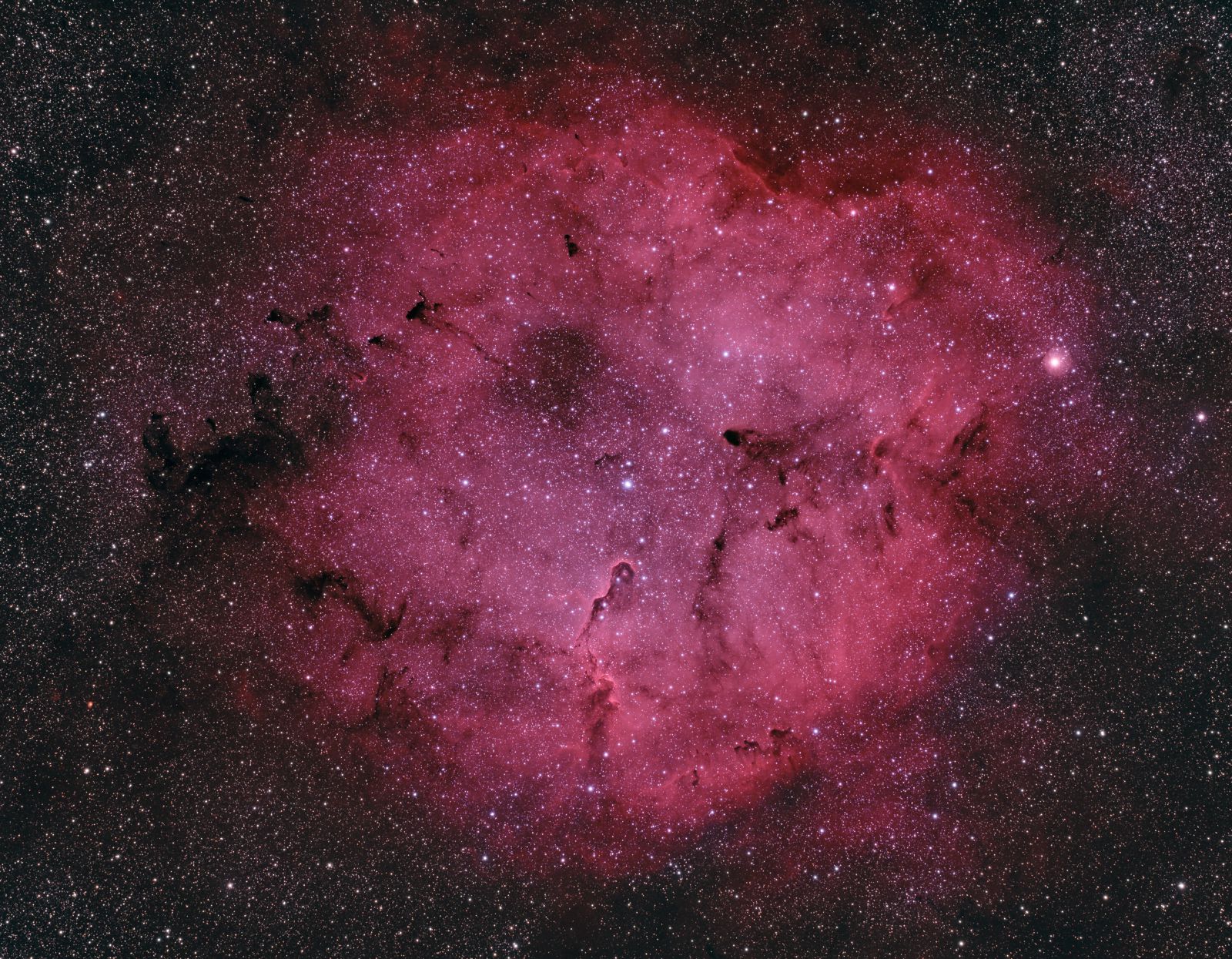IC 1396 in Narrowband Colour
 Click image for full size version
Click image for full size version
August 12, 2019
IC 1396 is a large cloud of faintly glowing gas, composed mainly of hydrogen. It is a huge object in the sky, with a diameter more than six times that of the Moon. That’s because it is both relatively close to us (2,400 light years) and big (more than 100 light years across). The energy that makes the nebula’s gas glow comes from the bright star at the centre of the nebula, called HD 206267. Jutting in from the 6 o’clock position is the Elephant’s Trunk Nebula, which features in another image I’ve taken of this object. The Elephant’s Trunk is a star forming region, and there are a number of very young stars — less than 100,000 years old — in its vicinity. IC 1396 is textured throughout with many dark nebula. It’s hard not to notice Mu Cephei, the brightest star in the image, near upper right. It is about 38,000 times as bright as the Sun. Bring your sunscreen.
Many people prefer these nebulae displayed in greyscale (black & white) images. I usually prepare both. You can find a greyscale version of my 2017 image of this object here. This image was acquired using a narrowband filter – a filter that passes only a few wavelengths of light — along with a colour camera. Since the image doesn’t contain all of the colours of light that stars and nebulae emit, the colours must be “tone mapped,” in other words, selected by me.
Tekkies:
Takahashi FSQ-106 ED IV @ f/3.6, QHY367C one-shot colour camera, and Optolong L-eNhance narrowband filter, Paramount MX, unguided. Acquisition, and focusing with TheSkyX. Focus with Optec DirectSync focus motor and controller. Automation with CCDCommander. Equipment control with PrimaLuce Labs Eagle 3 Pro computer. All pre-processing and processing in PixInsight. Acquired from my SkyShed in Guelph. Waning crescent Moon, average to above average transparency and fair to average seeing. Data acquired August 5-10, 2019.
118x10m with Optolong L-eNhance filter (Total = 19hr20m)
Image scale 2.59 arcsec per pixel
Data Reduction and Cleanup
Preprocessing: The BatchPreProcessing script was used to perform calibration, debayering, and registration of all frames. ImageIntegration followed by DrizzleIntegration with the CFA Drizzle option was used to make the master, which was then cropped.
Gradient Removal: DynamicBackgroundExtraction was applied twice, first using Division and then Subtraction.
Channel Registration: To improve channel registration, the RGB colour channels were extracted and aligned with ImageIntegration, using 2D Surface Splines with Distortion Correction and the Green channel as the reference frame. The registered colour channels were recombined with RGBCombination.
Luminance Extraction: RGBWorkingSpace was applied to normalize the channels, and the Luminance was extracted for separate processing as described below.
Colour
Colour Balancing: The colour image was colour balanced with ColorCalibration (note; this did not correct star colours, since this image used a narrowband filter)
Linear Noise Reduction: MultiscaleLinearTransform was used to reduce noise in the background areas, using an internal mask to protect bright structures. Layer settings for threshold and strength: Layer 1: 5.0 0.75 Layer 2: 3.0, 0.70 Layer 3: 2.0, 0.6 Layer 4: 1.0, 0.2.
Stretching: HistogramTransformation was applied to make a pleasing, bright image, with background set to an intensity of approximately 0.10.
Luminance
Deconvolution: StarMask was applied with default settings to produce a Local Deringing Support Image. A clone of the image was stretched to use as a deconvolution mask. Deconvolution was applied (80 iterations, regularized Richardson-Lucy, external PSF made using PSFImage script with about 30 stars). Because the image was so large, Deconvolution was applied to previews of the regions to be deconvolved, and the result inserted into the image using the SubstituteWithPreview script.
Linear Noise Reduction: MultiscaleLinearTransform was used to reduce noise in the background areas, using an internal mask to protect bright structures. Layer settings for threshold and strength: Layer 1: 3.0 0.9 Layer 2: 2.0, 0.75 Layer 3: 1.0, 0.6 Layer 4: 0.5, 0.2.
Stretching: HistogramTransformation was applied to make a pleasing, bright image, with background set to an intensity of approximately 0.10.
Recombining Luminance and RGB
LRGB Combination: The luminance image was applied to the RGB image using LRGBCombine with default settings.
Additional Processing
Nonlinear Noise Reduction: TGVDenoise was used in L*a*b* mode to reduce noise with a mask used to target the background areas and protect the stars (max. 1000 iterations and convergence selected for both lightness and chrominance).
Sharpening: MultiscaleLinearTransform targeting the lightness channel was used to sharpen Layers 2-4 with layers 2 and 3 with strengths of 0.1 and layer 4 having a strength of 0.05. A mask was used to limit sharpening to the regions of the nebula that showed the most detail.
Final Steps: Background, nebula and star brightness, contrast, hue and colour saturation were adjusted in several iterations using CurvesTransformation with masks as required. The DarkStructureEnhance script was applied with a strength of 0.3 and 8 layers. The image scale was returned to the native scale of the camera/telescope using IntegerResample to downsample by a factor 2.






Leave A Comment